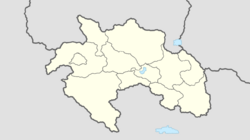Suidenland
Republic of Suidenland | |
|---|---|
| Motto: Hleďme vpřed ve svobodě Looking Forward in Freedom | |
| Anthem: Suidenwaltz Suiden: Jižanský valčík | |
 Location of Suidenland in Parthenia | |
| Capital | Klokov |
| Official languages | Suiden Suiden Sign Language |
| Recognised regional languages | Eisen Livoni |
| Government | |
• President | Roland Slezák |
• Prime Minister | Ivona Francová |
| Legislature | National Assembly |
• Water (%) | 3% |
| Population | |
• 2022 estimate | 12,415,808 |
• 2019 census | 12,401,589 |
| GDP (PPP) | 2020 estimate |
• Total | $581.130 billion |
• Per capita | $63,750 |
| GDP (nominal) | 2020 estimate |
• Total | $477.820 billion |
• Per capita | $53,320 |
| Gini (2019) | 26.7 low |
| HDI | very high |
| Currency | Suiden marka () (SMA) |
| Calling code | +655 |
| ISO 3166 code | SD |
| Internet TLD | .sd |
Suidenland (Suiden: Jihozem), officially the Republic of Suidenland (Suiden: Jihozemská republika) is a country located on the continent of Parthenia, bordering Eisenland to the north and Vermand to the east. It is a democratic historically neutral nation.
Etymology
The area that is present day Suidenland was first documented by the Remillians on their conquest of eastern Parthenia. The Remillians referred to the region as "Magnae Silvaeobscurae" or "The Dark Great Woods". This is most likely in reference to the Forest of Radimov in southern Suidenland.
The name "Suidenland" directly originates from Eisen, who named the land which is today Suidenland, "Het land in het Zuiden" or "The Land in the South" in around the 11th century. Overtime this evolved into Eisen footsoldiers referring to the land as "Zuidland", or literally "Southland". The name eventually caught on to the natives, using the name upon initial unification in the 16th century.
History
Prehistory
The lands which historically become Suidenland were some of the earliest inhabited lands from the Great Hominid Migration to the western world, being at the forefront of Parthenian inhabitancy. The initial Paleo-Kuthran people arrived to Parthenia from the Trianian landbrige and through the Anglish Peninsula. The first evidence of human inhabitation of Suidenland is in the Chropev cave system, with a skeleton being found dating back to around 9100 BP[1] although the likelihood is that inhabitants existed before this dating due to it's proximity to the Anglian Peninsula.
Magnae Silvaeobscurae
By the earliest century CE, Suidenland was inhabited by a completely different group to modern day, a group of Germanic peoples closely related to that of modern Eisenland or Angland.
Suidenland came under Remillian control in around 11AD when legionnaires began to march north in hope of conquest of barbarians from Eisenland, known as Incivilisunes, who had invaded Campoleone 10 years prior and sacked the city. Little did the scouts from Remillia know that in-between their civilised lands and the lands of the Germanic barbarians was a land full of more peaceful Germanic people, who had societal structure and civilisation in many different regions. These were the Reinsen People, early descendents of the modern Germanic group of Schwarzen People native to northern Suidenland. The Remillians made deals with many of the noblemen and minor kings of the regions to keep peace with them and support them if they took up loyalty to the Remillian Empire, which was agreed. The region was given the name "Magnae Silvaeobscurae", meaning "The Dark Great Woods", due to the deep forested areas in the south, with the Forest of Radimov.
Following this, many Reinsen soldiers were sent across the River Avonia and into Eisenland with the Remillians to conquer the barbaric people. This began the first of many establishing moments of great peace between the Reinsen and the Remillians.
Middle Ages
Following the collapse of the Remillian Empire the region was invaded by Baiuvarii, Eisens and Slavs. The region was conquered by Deserius of the Vermandans in AD 773 and introduced Christianity to the region. As part of Western Vermacia a majority of the core land that now encompasses Suidenland was handed to the House of Babineux in 783.
The first record showing the name Suidenland is from 1096, where it is written as "Sortgouuemarisk", or "South Marsh", by early Eisen-Vermancish.
Suiden Empire
20th Century
World War 1
Interwar and Involvment in World War 2
United Nations
Contemporary History
Geography
Politics
Demographics
Economy
Culture
Sports
The national sport of Suidenland is football, as with much of Parthenia. However, Suidenland is most known for being the credited place of the foundation of football, with the first recorded match taking place in 1836 in Královnin park, central Klokov. The country remains consistently good at the sport, ranked number seven in the world standings as of 2022. The national football league in Suidenland is the Jihozemská superliga, one of the top leagues in Eastern Parthenia.
References
- ↑ "The Chropev Man dates to around 7100 BC, making him one of eastern Parthenia's eldest known skeletons
Notes


